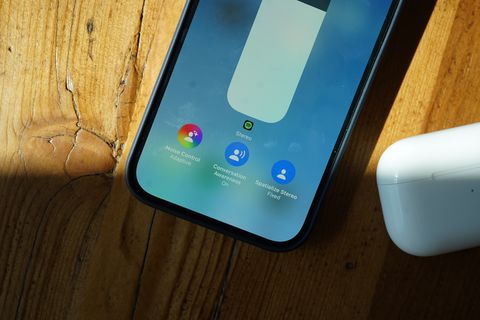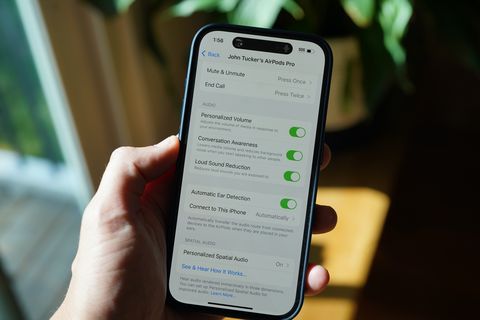Last year, Apple released new AirPods Pro — often referred to as AirPods Pro (2nd-Gen) or AirPods Pro 2 — with double the active noise-cancellation, an improved transparency mode (called Adaptive Transparency), on-stem volume touch controls and a charging case that supported Precision Finding and had a built-in speaker. They were a big upgrade.
Just a year later, Apple has released even newer AirPods Pro that are, well, just a little bit of an improvement. They add dust resistance and USB-C charging, but everything else — fit, sound, noise-cancellation, price and so on — is the same.
-
 Apple Apple AirPods Pro (2nd-Gen, USB-C) Read More
Apple Apple AirPods Pro (2nd-Gen, USB-C) Read More
If you bought new AirPods Pro in the past year, there's little reason to upgrade to the new models. But that's also because, thanks to the release of iOS 17, Apple has rolled out some new features to both 2022- and 2023-released AirPods Pros via a software update. Each now supports Adaptive Audio, Personalized Volume and Conversation Awareness — and these are the real upgrades.
We talked with Ron Huang, VP of Sensing and Connectivity at Apple for some insight as to how these features were made possible, and how to get them to work for you. It's also worth mentioning that these features are powered by Apple's H2 chipset, which is only in the second-generation AirPods Pro; you can't get them in any other AirPods, including the first-generation AirPods Pro or AirPods Max.
What is Adaptive Audio?
Adaptive Audio is a setting that takes advantage of both active noise-cancellation and transparency modes. With AirPods Pro, you previously had to pick between the two modes — or just turn them both off — but with Adaptive Audio turned on, your AirPods Pro monitors the ambient sounds around you and then adjusts the ANC and transparency levels accordingly.
"The goal is to find the best midpoint between the two modes to really match your environment correctly," explained Huang. "And the key is to make everything sound natural. Even if you're in transparency mode, as we increase ANC level to alleviate the noise around you, we want to make sure that everything sounds normal."
Essentially, Adaptive Audio is a kind of "catch all" setting for people who are either moving around between environments a lot or have people moving around them; say you're in your kitchen, but you have family members making noise around you. That said, in my experience, Adaptive Audio never goes full ANC or full transparency, so if you're in a stable environment —which is either really quiet or constantly loud — there's a reason why the dedicated ANC and Transparency modes are still there.
What is Personalized Volume?
Personalized Volume might be the most interesting of the three new features. It's a setting that blends active noise-cancellation and the volume of your music (or podcast). When turned on, your AirPods Pro monitors the sounds of your environment and then automatically adjusts volume and ANC levels so that what you're listening to sounds best.
"If there's too much ANC, you start to become less connected to the world around you," said Huang. "And if you amp up the volume of the content around you, well, it's too loud." Huang explained that Apple built special machine learning algorithms — based on tens of thousands of hours of listening data from different users, listening to different content, at different volumes, in different environments — to maximize the signal-to-noise ratio inside your ear.
It's one thing for the AirPods Pro to adjust the volume and ANC levels based on your environment, but it's another thing to be personalized — because nobody listens to music or podcasts the same exact way. Huang explained that when Personalized Volume is first turned on, its loudness and ANC settings are initially based on (again) tens of thousands of hours of data, but your AirPods Pro will gradually learn what settings you like and then become more personalized over time. (This "memory" starts when your iPhone is running iOS 17.)
I've been listening to my AirPods Pro with Personalized Volume turned on and, from what I can tell, I'm adjusting the volume less and less. That said, as somebody who likes to run with the AirPods Pro on full blast, I've had to toggle it off so that I could really make sure the volume was at its max.
What is Conversation Awareness?
Conversation Awareness is a feature that aims to help you more naturally have a quick conversation with somebody — say "Hi" or give quick directions — without having to manually pause or lower the volume of what you're listening to. Essentially, your AirPods Pro does this automatically when they detect that you're speaking to somebody.
Huang explains that when your AirPods Pro detects you speaking, they will automatically switch to transparency mode...but they will then focus on the person you're speaking to so that they sound clearer to you. "For this we use beam-form to track the speaker in front of you," Huang explained. "And also we enhance the speech frequencies so that despite the loudness around you, the speech of the person you're talking to still sounds clear."
There are other layers to Conversation Awareness, too, as it works differently based on what kind of content you're listening to. If you're listening to music, the AirPods Pro lower the volume but don't pause it. If you're listening to a podcast "where every word matters," your AirPods Pro pause it. And then when AirPods Pro detects that you're done talking, they start playing whatever you were listening to at its previous volume and settings.
Lastly, Conversation Awareness is smart enough to know when you're making sounds but not talking — like if you cough or are talking to yourself. Huang explained that Apple built a "sensor fusion algorithm" that works with the built accelerometer and microphone on AirPods Pro to determine if you have an "intent to talk." If you're not making "speech sounds," then your AirPods Pro changes nothing.
In my several weeks of testing, Conversation Awareness works really well and pauses and lowers the volume of what you're listening to. My only complaint is that sometimes it takes a little long — like 5 or so seconds — for it to start playing your music back to normal again.
How to change the settings of your AirPods Pro
You can adjust the newest settings — Adaptive Audio, Personalized Volume and Conversation Awareness — on your AirPods Pro by following pretty much the same steps. (The outlier is Personalized Volume, which can only be turned on/off via Settings.)
From Settings:
- While wearing your AirPods Pro, open the Settings app on your iPhone.
- Select your AirPods Pro.
- You can toggle on/off each of the three settings from this screen.
From the Control Center:
- While wearing your AirPods Pro, swipe down from the top-right to access the Control Center.
- Long press on your volume slider.
- From here, you can toggle Adaptive Audio and Conversation Awareness on/off.






















